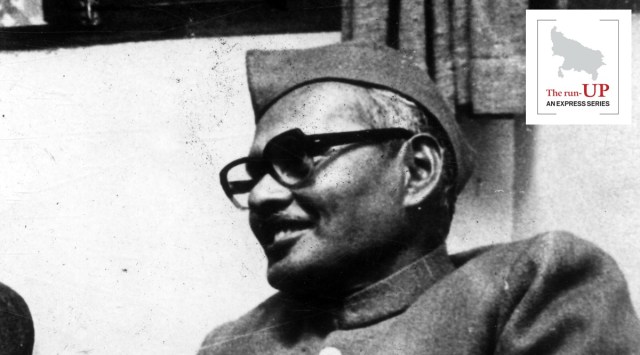Shyamlal Yadav is one of the pioneers of the effective use of RTI for investigative reporting. He is a member of the Investigative Team. His reporting on polluted rivers, foreign travel of public servants, MPs appointing relatives as assistants, fake journals, LIC’s lapsed policies, Honorary doctorates conferred to politicians and officials, Bank officials putting their own money into Jan Dhan accounts and more has made a huge impact. He is member of the International Consortium of Investigative Journalists (ICIJ). He has been part of global investigations like Paradise Papers, Fincen Files, Pandora Papers, Uber Files and Hidden Treasures. After his investigation in March 2023 the Metropolitan Museum of Art, New York returned 16 antiquities to India. Besides investigative work, he keeps writing on social and political issues. ... Read More
Ram Naresh Yadav, 10th UP CM, controversial ex-MP governor
After Janata Party swept UP in 1977 following the Emergency, Ram Naresh took over as CM; during his nearly one-year-ten-month tenure, he implemented a 15% quota for OBCs in govt jobs
 Ram Naresh resigned from the Janata Dal and joined the Congress in 1989 (Express Archive photo)
Ram Naresh resigned from the Janata Dal and joined the Congress in 1989 (Express Archive photo)Accounting for 80 of the Lok Sabha’s 543 seats, and a 403-member Assembly, Uttar Pradesh, with its over 15 crore voters, is India’s most politically significant state. Since January 25, 1950, when the United Provinces was renamed as Uttar Pradesh, the state – through 17 Assembly elections — has determined the course of national politics, throwing up a legion of stalwarts, chief ministers, and Prime Ministers. Of its 21 CMs though, only Yogi Adityanath, Akhilesh Yadav and Mayawati have completed a full five-year term, reflecting the intense volatility of its politics. In the line-up of CMs, also lies the truth about the state’s caste equations. Ten of its 21 CMs have been Brahmins or Thakurs. The remaining include three Yadavs, three Baniyas, one Lodh, one Jat, one Kayasth, one Dalit and one Sindhi. A series looking at UP’s political history and changes through its CMs.
***
When the Janata Party triumphed in the March 1977 Lok Sabha elections after the Emergency, Ram Naresh Yadav won from Azamgarh as its candidate. Three months later, when the Janata Party swept the UP Assembly polls as well amid an anti-Congress wave, Ram Naresh was chosen as its Chief Minister.
On June 23, 1977, Ram Naresh was sworn in as the 10th UP CM. He won the CM’s post in an interesting race. Besides him, there was another contender, Ram Dhan, the Janata Party MP from Lalganj(SC) seat, who had won it twice earlier on the Congress ticket. Chaudhary Charan Singh backed the candidature of Ram Naresh, an Other Backward Classes (OBC) leader, as the CM, while another state stalwart Chandrashekhar supported Ram Dhan, a Dalit leader. Ram Naresh won the race, while Banarsi Das was unanimously elected as the Assembly Speaker.
In the 1977 UP Assembly polls, the Janata Party secured more than two-thirds majority by winning 351 seats. The Congress was able to win just 46 seats, the CPI 9, and the CPI(M) 1. A five-member ministry headed by Ram Naresh took over, which initiated various steps to uplift the poor and downtrodden, and curb corruption. The Ram Naresh government, however, rapidly lost its reputation.
Ram Naresh could continue as the CM for nearly a one-year-ten-month period from June 23, 1977, to February 27, 1979, during which he implemented15 per cent reservation for OBCs in government jobs – a move that boosted the OBCs’ representation in such jobs in UP.
Born in 1928, Ram Naresh completed his MA and LLB degrees from Banaras Hindu University (BHU) and practised law in Azamgarh from 1953. He went to jail several times, amounting to 19 months, during the Emergency. Unlike his CM predecessors like CB Gupta, Charan Singh and HN Bahuguna, who began their political innings with the Congress before switching to other parties, Ram Naresh’s was the opposite case, starting from the Charan Singh-led Bharatiya Lok Dal (BLD) and ending with the Congress.
He was dubbed “Gandhi of Purvanchal” because of his simplicity, but ironically his political career ended amid allegations of corruption in the Vyapam recruitment scam in Madhya Pradesh when he was governor there during 2011-16.
After the June 1977 polls, the first UP Assembly session started on July 12, 1977, with the governor, in his address, announcing the implementation of the Lokayukt Adhiniyam with immediate effect, which was applicable to every public servant barring the CM, even though the governor said his government was in favour of bringing the CM’s office under its ambit too.
While a first-time MP Ram Naresh took oath as the CM, there were leaders like Mulayam Singh Yadav, an MLA since 1967, who were ignored for the top post as Charan Singh was in favour of Ram Naresh’s candidature.
After resigning from his Azamgarh parliamentary seat to head the UP government, Ram Naresh was elected to the Assembly in a by-election from Nidhaulikalan in Etah. In the 1978 Azamgarh bypoll, however, the Janata Party candidate lost to the Congress’ Mohsina Kidwai.
On February 15, 1979, Ram Naresh resigned (however continued as interim CM and his successor took oath on February 28, 1979). He had to resign as the Janata Party members, who were with Bhartiya Jan Sangh (old version of BJP) before the formation of Janata Party, had resigned on February 11, 1979 from his cabinet due to their association with the RSS because of “dual-membership” issue and on February 14, 1979, the Yadav government had issued an order that RSS shakhas should not be held at public places without permission.
When the Janta Party split, Ram Naresh went with Charan Singh and contested Nidhaulikalan in 1980 on his Janata Party (Secular) ticket but lost. In 1985 he won from Shikohabad as an Independent candidate. On March 28, 1988, he was elected to the Rajya Sabha as a Lok Dal nominee, but amid the growing OBC movement in North India in the late 1980s, he joined the Congress and got elected to the Rajya Sabha as its candidate. In the 1996 Assembly polls, he was elected from Phulpur on the Congress ticket. In 2002 polls, he won from the Phulpur Assembly seat as a Congress candidate. In the 2004 general elections, he contested and lost from Azamgarh though. He was appointed the MP governor in 2011 by the then Congress-led UPA government.
Since the 1970s, Mulayam, Balram Singh Yadav, Chandrajeet Yadav and Ram Naresh emerged as leading Yadav leaders in UP, who were often political rivals. When Balram was appointed the UP Congress chief in the late 1980s, Mulayam was heading the UP Janta Dal. Upset over Mulayam’s appointment as the state party chief, Ram Naresh resigned from the Janata Dal and joined the Congress in 1989.
Ram Naresh was known for his simplicity. While on way to the Raj Bhawan to take oath as the CM, he had travelled in a rickshaw and also did the same while returning after submitting his resignation to the governor. His image, however, came under cloud of alleged corruption in the later years of his life. He passed away on November 22, 2016, in Lucknow.



- 01
- 02
- 03
- 04
- 05





























